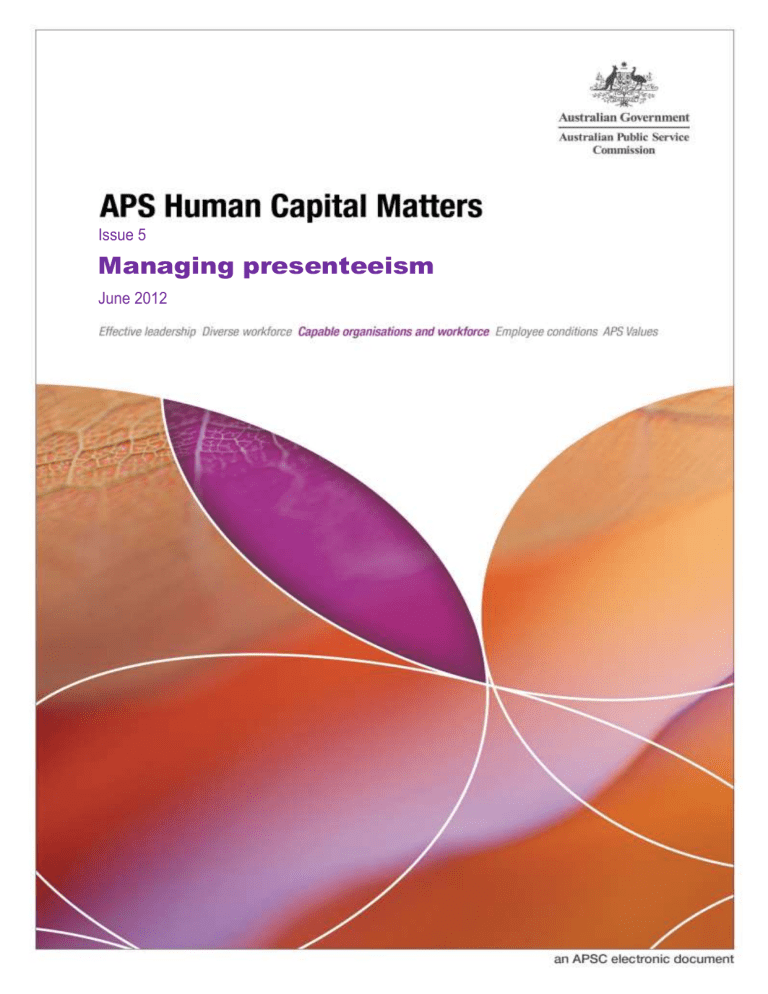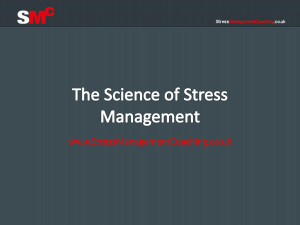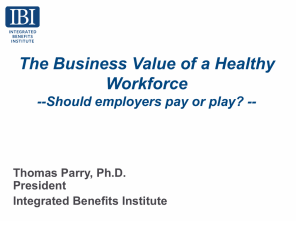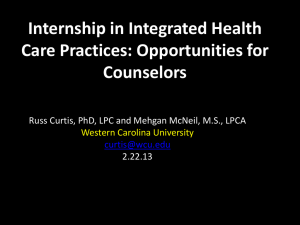Managing presenteeism - Australian Public Service Commission

Issue 5
Managing presenteeism
June 2012
APS Human Capital Matters: Managing Presenteeism
June 2012, Issue 5
Editor’s note to readers
Welcome to the fifth edition of Human Capital Matters for 2012—the digest for time poor leaders and practitioners with an interest in human capital and organisational capability. This edition focuses on the management of presenteeism within the public, private, research and voluntary sectors.
As a concept, presenteeism is fairly recent but it is gaining significant prominence in both the academic and practitioner literature as an important part of the debate on productivity in the modern workplace. A single unified definition of presenteeism does not yet exist. Some definitions focus on the issue of sick employees being at work and not being productive; however, the subject is much broader—a more accurate definition would encompass a number of possibilities (e.g. physical or mental ill-health, disillusionment with the workplace, a protest element at perceived unfairness, poorly functioning work-life balance arrangements etc.)
While sickness presenteeism has received the most research attention, presenteeism is a poorly understood term that can be associated with three meanings: 1) people attending work even though they are sick; 2) putting in long hours but not working all the time; and 3) working at a reduced level due to other distractions such as browsing the Internet or playing games. Perhaps the main source of agreement among authors is that presenteeism is not only more difficult to identify and measure than absenteeism, but that its cost to the economy is far greater than that of absenteeism.
Ashby and Mahdon’s paper notes the more common assumption that absenteeism is costlier than presenteeism but then proceeds to demonstrate how the contrary is actually the case. Using survey results from a large private sector employer, Gilbreath and Karimi examine some broader aspects of presenteeism by looking at how supervisor behaviour influences employee behaviour, in particular the important role that supervisors can play in supporting employee productivity.
Goetzel et al provide a comprehensive report on the cost of a range of physical and mental health conditions and also show that presenteeism is the leading driver of costs associated with these health conditions.
Holt examines a range of indirect costs faced by employers, in particular presenteeism and suggests a number of approaches for resolving the presenteeism problem faced by employers.
The Medibank paper in many ways initiated the presenteeism debate in Australia in earnest; produced by one of the more reputable accountancy companies it provided some of the first
“hard” data to support the concept of presenteeism. The paper by Prater and Smith looks at presenteeism at a global level and, consistent with other papers in this issue of Human Capital
Matters finds the costs associated with presenteeism exceed those of absenteeism. Finally,
Widera et al look at the health costs of presenteeism in a nursing home environment and cast presenteeism as a real potential health hazard in the workplace.
About Human Capital Matters
Human Capital Matters seeks to provide APS leaders and practitioners with easy access to the issues of contemporary importance in public and private sector human capital and organisational capability. It has been designed to provide interested readers with a monthly guide to the national and international ideas that are shaping human capital thinking and practice.
2
Comments and suggestions welcome
Thank you to those who took the time to provide feedback on earlier editions of Human Capital
Matters. Comments, suggestions or questions regarding this publication are always welcome and should be addressed to: humancapitalmatters@apsc.gov.au
. Readers can also subscribe to the mailing list through this email address.
Katherine Ashby and Michelle Mahdon, ‘Why Do Employees Come to Work
When Ill?: An Investigation into Sickness Presence in the Workplace’,
The
Work Foundation and AXA PPP Healthcare, London, April 2010, 69 pp.
The authors begin by noting the commonly accepted assumption among private and public sector leaders that absenteeism is a larger problem than presenteeism simply because it is more clearly visible and therefore measurable statistically. However, their study found that ‘sickness presence’ (where an employee attends work but is unwell) may account for up to 50% more working time lost than absenteeism. The study is based on a survey of 510 employees of the leading health insurer AXA PPP Healthcare aged between 24 and 69 years (69% of those surveyed were women).
The survey results suggest that sickness presence not only affects productivity but may well contribute to increased sickness absence later because attendance while ill can exacerbate an employee’s condition. The authors conclude that addressing the underlying factors responsible for presenteeism is also likely to reduce absenteeism. The study’s main findings were as follows:
Sickness presence is more prevalent than sickness absence—45% of respondents reported at least one day of it during the reporting period versus 18% reporting at least one day of sickness absence.
The main factors causing employees to come to work when unwell were personal financial difficulties, work-related stress and perceived pressure to attend from either managers or colleagues.
Presenteeism originating in illness adversely affects work performance and is also associated with inadequate lower line management supervision and reduced psychological wellbeing.
Sickness presence has a much more negative impact on overall job performance than absenteeism does.
Employees who felt pressured to attend work were more likely to report that their job performance was adversely affected when they did so.
The level of presenteeism is a useful indicator of general employee health and wellbeing.
The authors make a number of recommendations for addressing presenteeism challenges. They argue that the focus should be on ‘health management’ and not ‘absence management’: rather than emphasising measurement, organisations ought to devise health and wellbeing programs designed to counter presenteeism and improve workplace conditions. Risk assessment by managers in the daily course of their duties is also advocated, that is, looking for early signs of presenteeism such as stress as well as indications of poor engagement. They also recommend training managers in these skills. In addition, the authors suggest reviewing absence policies in order to assess how effectively managers are interpreting them.
The Work Foundation is the leading independent authority on work and its future in Great
Britain; AXA PPP Healthcare is a large UK health insurer.
3
Brad Gilbreath and Leila Karimi, ‘Supervisor Behaviour and Employee
Presenteeism’, ‘International Journal of Leadership Studies’,
Vol. 7, No. 1,
2012, pp. 114–132.
At the outset, the authors point out that most research on presenteeism is related to that resulting from employees’ health problems. To support this contention, they cite a number of definitional examples, for instance, ‘the problem of workers being on the job but, because of illness or other medical conditions, not fully functioning’. However, they assert that a wider definition and focus is required; they also emphasise the need for authors of studies of presenteeism to outline precisely what aspect of the subject they are dealing with (e.g. presenteeism caused by health difficulties, or, an employee who, though at work, is not fully engaged due to problems at home or dissatisfaction arising from workplace factors such as the perception that he or she may be
‘carrying’ other employees).
Accordingly, the authors investigated a little-explored aspect of presenteeism: the role of supervisor behaviour in producing employee presenteeism levels related to stress. The study is based primarily on a questionnaire completed by the staff of two large Australian hospitals; 400 employees were surveyed and 180 responded (a 45% response rate). The survey sought to ascertain how often staff experienced stress-related presenteeism and to what degree this arises from the behaviours of their supervisors. In interpreting the results the authors used the
‘Supervisor Practices Instrument’ (SPI), which was created for this purpose. They found there was a positive correlation between job stress and presenteeism. More specifically, the findings revealed negative and positive supervisor behaviour to be associated with employees’ job-stressrelated presenteeism. Furthermore, the survey results indicated that negative supervisor behaviours have the strongest associations with employee job-stress-related presenteeism.
The study identified a number of positive supervisor behaviours that may affect employee presenteeism levels. These include supervisors helping employees to keep their work in perspective, that is, in balancing work and home life. A significant characteristic of the article is its call for a ‘broadening’ of the concept of presenteeism. The authors see it as a workplace factor with many causal antecedents and one that requires close and constant monitoring by supervisors. For this, support from the organisation’s leaders combined with regular attention to employee behaviour and productivity levels by managers is essential.
Brad Gilbreath is an Associate Professor at the Hasan School of Business at Colorado State
University—Pueblo; Leila Karimi is a Lecturer in the Health Service Management Program at
La Trobe University.
Ron. Z. Goetzel et al, ‘Health, Absence, Disability, and Presenteeism Cost
Estimates of Certain Physical and Mental Health Conditions Affecting US
Employers’, ‘Health and Productivity Cost Estimates’, American College of
Occupational and Environmental Medicine (ACOEM), Elk Grove Village, Ill.,
2004, pp. 398–413.
This article links employee self-reporting statistics for the top 10 most costly physical and mental health conditions for which direct medical expenditures were highest among US employers. Data for the study was drawn from a medical/absence database comprising the results of two surveys—the first, of 6,003 employees (a 26% response rate) and the second, of 3,910 employees (a 28% response rate). Several published productivity surveys were also used to inform study analysis. Ranges of ‘condition prevalence’ and associated absenteeism and presenteeism losses were utilised by the authors to estimate the costs of these conditions to
4
organisations. Although the overall economic burden of illness was highest for hypertension
(stress) ($392 per eligible employee per year), heart disease ($368), and arthritis ($327), presenteeism costs (despite being difficult to measure) were estimated to be higher than medical costs in most cases—presenteeism represented between 18% and 60% of all costs for the 10 health conditions. It was the largest component and leading driver of overall costs (61%).
Other significant factors in influencing presenteeism were depression/sadness, mental illness, allergy, migraine/headache and diabetes. Presenteeism costs were most pronounced in employees/patients with migraine/headache (89%), allergies (82%) and arthritis (77%).
Presenteeism costs had the lowest effect on total costs attributable to heart disease (19%) and respiratory infections (25%). The article also discusses a number of initiatives which have been designed to measure losses arising from presenteeism. These include the 23-item Health
Limitations Questionnaire (HLQ), developed at the Erasmus University Rotterdam Institute for
Medical Technology, which collects data on the relationship between employee illness, treatment and work performance. The HLQ has been used on several segments of the population with health related difficulties affecting their workplace functioning, notably, those with migraine problems and patients/employees with hip or knee conditions. Another such tool (though not widely trialled at the time of writing) was the Work Productivity and Activity Impairment
Questionnaire (WPAI), a US initiative. These tools were designed to measure overall productivity losses due to the effects of a particular health condition only.
Dr Ron. Z. Goetzel is based at the Institute for Health and Productivity Studies at Cornell
University.
Heather Holt, ‘The Cost of Ill Health’ (Report for the New Zealand Treasury)
(New Zealand Treasury Working Paper No. 10/04), The Treasury,
Wellington, November 2010, 78 pp.
This report, based on extensive research, examines the effects on the New Zealand economy of indirect costs to employers—in particular, presenteeism. It draws substantially on Statistics New
Zealand’s SoFIE (Survey of Family, Income and Employment) data. Of the adult working population surveyed, almost half reported reduced productivity due to emotional problems or physical health difficulties during the previous four weeks. Evaluated on the basis of the average full-time pay rate, this was estimated to cost the country between $700 million (39.3 million work hours lost) and $8.2 billion (409 million work hours lost) per year (this range was calculated by estimating illness-related reductions in productivity of between 15% and 50%). A mid-range figure represents a loss in GDP of 2.7%.
The report points out that although absenteeism rates can be measured through ‘direct’ methods such as statistics on sick leave days lost, losses due to presenteeism are greater and difficult to detect. Examples include: additional stress on other team members called upon to temporarily fill the gap created by an employee whose productivity is declining; missed deadlines which can lead to dissatisfied clients; a decline in work quality resulting from staff being placed in unfamiliar roles when they replace those not performing effectively; and the most common contributors to presenteeism, namely, employees’ insistence on coming to work when they are not in a condition to perform their duties efficiently, and employee resistance to engaging themselves for reasons of dissatisfaction with their work or supervisor. In New Zealand, as in most countries, the costs of presenteeism to the economy exceed those of absenteeism.
The author suggests a number of approaches for resolving the presenteeism problem. First, she argues for a stronger focus on managing health in the workplace by, for example, encouraging more positive management and employee attitudes towards the ‘sick day’. Secondly, she
5
recommends conducting a health audit of employees so as to identify health risks within an organisation and better address them. Thirdly, she proposes the introduction of greater workplace flexibility in terms of hours worked and options such as working from home. Also recommended is subsidised health insurance to enable employees to secure more affordable access to medical treatment and thereby reduce their anxiety about the costs of (often unexpected) health procedures and/or hospitalisation. The author asserts that these initiatives frequently pay for themselves by negating direct illness-related costs alone.
Heather Holt is a former staff member of the New Zealand Treasury.
Medibank, ‘Sick at Work: The Cost of Presenteeism to Your Business and the
Economy’, Medibank, July 2011, 11 pp.
In 2007, Medibank Private commissioned an independent consultancy firm to identify the costs to, and impact of, presenteeism on the Australian workforce and economy. The resulting study estimated that in 2005–06 the cost was $25.7 billion—nearly four times that of absenteeism. This report revisits the subject and also considers the impact of the ageing working population on presenteeism as well as the cost of presenteeism within the context of the Global Financial Crisis
(GFC). The study found that in 2009–10 the estimated cost of presenteeism to the economy was
$34.1 billion; on average, 6.5 working days of productivity were lost per employee annually as a result of presenteeism. These findings equated to a 2.7% decrease in 2010 GDP.
A specialist methodology was used to calculate the cost to the Australian economy of productivity losses due to presenteeism in the workplace. The presenteeism costs identified in the report are made up of: the direct costs faced by employers due to the on-the-job productivity losses caused by presenteeism; the indirect costs to the Australian economy arising from lower labour productivity levels arising from presenteeism; and the indirect costs to the economy originating in other secondary factors. The study identified and analysed four principal causes of presenteeism: unhealthy lifestyles; workers with illnesses going to work; allergies and asthma; and poor work-life balance and high levels of job-related stress. In its discussion of the fourth factor, for example, the report revealed that workplace stress was responsible in 2007–08 for an annual loss of 2.14 working days per employee as a result of presenteeism. This equated to a cost of $533 per employee each year.
The study also considered the impact of 12 medical conditions on presenteeism and found that the largest contributors to overall productivity loss caused by presenteeism are depression (21%), allergies (17%), hypertension (13%) and diabetes (12%). It found that although managers generally tackle physical symptoms of illness fairly quickly, mental health issues are not addressed as fast. The authors set out three approaches for organisations to adopt in order to combat presenteeism: awareness; identification; and education. More specifically, this could translate to organisations making greater use of risk assessments for staff; more widespread use of employee assistance programs; and greater employer preparedness to establish wellness programs (and employee preparedness to access them).
Medibank is Australia’s largest health insurer.
Tammy Prater and Kim Smith, ‘Underlying Factors Contributing to Presenteeism and
Absenteeism’, ‘Journal of Business and Economics Research’,
Vol. 9, No. 6, June 2011, pp.
1–15.
This article represents the latest thinking on presenteeism (and absenteeism). It is based on the recognition that presenteeism may have several causes—both inside the workplace and outside.
The authors quote research which indicates that in 2010 the cost of presenteeism globally was
6
$180 billion, surpassing that of absenteeism—$118 billion. The authors note the almost exclusive past focus on ill-health as the primary factor behind presenteeism. A literature review and a number of surveys aimed at different categories of employees were conducted to determine the factors responsible for specific forms of presenteeism, for example, health-related stress, workplace anxiety arising from perceived discrimination by supervisors, and workplace uncertainty due to the economic climate.
In addition to the main presenteeism health factors identified in existing research (e.g. migraine, diabetes, obesity), the authors’ research singled out one little-examined major practice responsible for rising rates of presenteeism—employees conducting personal business during working hours. The authors also found that men conducted personal business for 1.2 hours more per day than women did. The authors’ research reveals that as employees increasingly fear job losses and reprimands for excessive time off to deal with child- and aged-care responsibilities, they are more and more likely to conduct personal business while at work.
The report also refers to similar findings by other researchers. A May 2008 study found that there had been an average of approximately seven days of presenteeism per employee during that month (and this was two months before the Global Financial Crisis (GFC) events began to unfold). Other research indicated that, at the height of the swine flu epidemic of 2009 during the
GFC, 71% of American employees were more likely to go to work because they feared job loss or did not want to miss a job deadline at work. The same study found that an employee can spend 2.4 hours per week in dealing with non-related medical issues. The article quotes a Risk &
Insurance magazine report that the root causes of presenteeism are not always medical but rather just as often issues relating to childcare, financial problems, addiction, divorce or other family difficulties. Another significant factor, acknowledged in this (as in most other research) is employees going to work while ill in order to preserve their sick leave entitlements and not performing effectively while at work as a result. Retaliation by employees against employers for a variety of reasons was also identified as a factor (though not one yet explored in detail).
Tammy Prater is Professor of Management and Kim Smith is an Instructor of Management at
Alabama State University.
Eric Widera, Anna Chang and Helen L. Chen, ‘Presenteeism: A Public Health
Hazard’, ‘Journal of General Internal Medicine’, Vol. 25, No. 11, November
2010, pp. 1244–1248.
This is a case study of presenteeism behaviour associated with an outbreak of viral gastroenteritis at a nursing home in January 2005 (the country is not identified). It resulted in some 50 residents and nursing staff becoming infected. The authors use a brief literature survey as a means of highlighting the hazards of presenteeism in the health care sector; discuss factors that may influence health care employees to come to work when ill; and propose policy changes aimed at reducing the incidence of presenteeism in health care organisations at a time of high health risk to nursing staff and those they care for. The article seeks to fill the gap in studies of the relationship between presenteeism and infectious disease transmission in healthcare settings.
In the instance dealt with in this article, presenteeism proved to be a key risk factor in transmitting symptoms and extending the duration of the outbreak. On the basis of their investigation, the authors conclude that health care personnel who return to work despite having ongoing symptoms of an infectious disease extend the risks of presenteeism far beyond reduced productivity into ‘the realms of patient safety and public health’.
7
The article quotes research indicating that medical and nursing staff are highly likely to come to work while having conditions such as influenza instead of remaining at home. A survey of 1,015
Norwegian physicians found that in one year 80% of them went to work with a medical condition for which they would have ‘sick listed’ a patient. Two-thirds of these episodes involved a possible contagious disease such as respiratory or gastrointestinal infections. The authors also refer to research showing that understaffing and increasing time pressures were key factors in increasing presenteeism among aged care workers in Nordic countries.
A study of Australian nurses found that a sense of tension arose for nurses when determining whether to come to work when ill. This originated in previous interactions with supervisors who questioned the legitimacy of prior illnesses and focused on the need to report illnesses within a timeframe that would ensure the adequacy of replacement staffing. The authors put forward a number of suggestions for addressing this problem, for example, making available unrestricted paid sick leave for all employees working in a healthcare setting in order to decrease the financial pressure to return to work when ill, and introducing measures designed to relieve staff of acute personal responsibility feelings for taking leave when ill which encourage presenteeism.
Eric Widera, Anna Chang and Helen L. Chen are based at the Division of Geriatrics, University of California at San Francisco.
8







